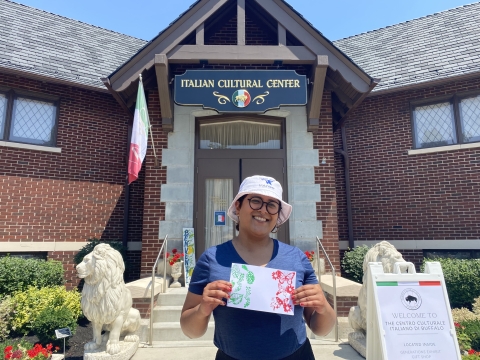With several partners, the Buffalo Urban Wildlife Refuge Partnership engages youth in learning about native habitats, water systems and waterway connectivity, while working on habitat restoration projects such as invasive species invasive species
An invasive species is any plant or animal that has spread or been introduced into a new area where they are, or could, cause harm to the environment, economy, or human, animal, or plant health. Their unwelcome presence can destroy ecosystems and cost millions of dollars.
Learn more about invasive species removal, water culvert assessments and a stormwater management and beautification demonstration project.
Celebrating our amazing Urban Wildlife Refuge Intern!
During summer of 2023, Iroquois National Wildlife Refuge was able to host an Urban Wildlife Refuge Intern that worked mainly in Buffalo, NY with our partner Buffalo-Niagara Waterkeeper and partly on the refuge. Wasiq Ahmed was our amazing urban intern that was able to participate in plantings around local parks and riparian riparian
Definition of riparian habitat or riparian areas.
Learn more about riparian areas, ecological site assessments, water quality testing, and trail maintenance. She took part in major outreach events such as the Italian Heritage Festival and Erie County Fair. Her biggest accomplishment was creating a new relationship between the wildlife refuge and the Gloria J. Parks Community Center. She was able to offer weekly nature programs to a class of 1st graders and kindergarteners that consisted of taking a walk around their own neighborhood to learn about the plants, nature journaling, mammal furs and tracks, and making animal masks! To finish off the summer we were able to get the students from the community center out to the wildlife refuge! During their 3-hour visit, the students made their own tree cookie name tag, explored the interactive exhibits in our visitor center, listened to a book reading about wetlands, visited our observation deck at the Cayuga Overlook to observe the birds, and took a mile walk on the Kanyoo Trail! Many of the students said that they have never been in a forest before and that they never want to leave! This is why we do what we do for the urban program and the community that lives in Buffalo!
Urban 'Learn to Fish' Series makes a splash!
Lower Great Lakes FWCO piloted a new urban “Learn to Fish Series” this summer in the City of Buffalo, starting on June 9th. The monthly event was held at Buffalo Harbor State Park in partnership with New York State Office of Parks, Recreation and Historic Preservation. Fish biologists provided instruction to adults and families about the basics of fishing and fish handling, species found in the area, different bait/lure types, different methods to catch different species and learn/practice basic knot tying. Loaner equipment was provided to participants for this free fishing clinic. At the final program, each of the 13 participants was able to catch at least one fish - for many, it was their first fish ever!
Helping pollinators at Buffalo’s Tapestry Charter School
After some delays due to weather and air quality issues from wildfires north of the border, staff from the Lower Great Lakes Fish and Wildlife Conservation Office (FWCO) got out to Buffalo’s Tapestry Charter Middle School as part of our Buffalo Urban Wildlife Refuge Partnership. On June 13th, fifth grade science teacher Jessica Kauffman had her four classes of 100 students plant native flowering plants in a new pollinator garden on their campus. Prior to this, partners from the Niagara Greenway Commission, Reinstein Woods Nature Preserve, Buffalo Niagara Waterkeeper, and Lower Great Lakes FWCO visited the school to discuss the importance of pollinators and then students were paired up to become “plant experts” on the types being used in the garden. Now, the fifth graders will be able to watch the garden grow as they move through their middle school years.




